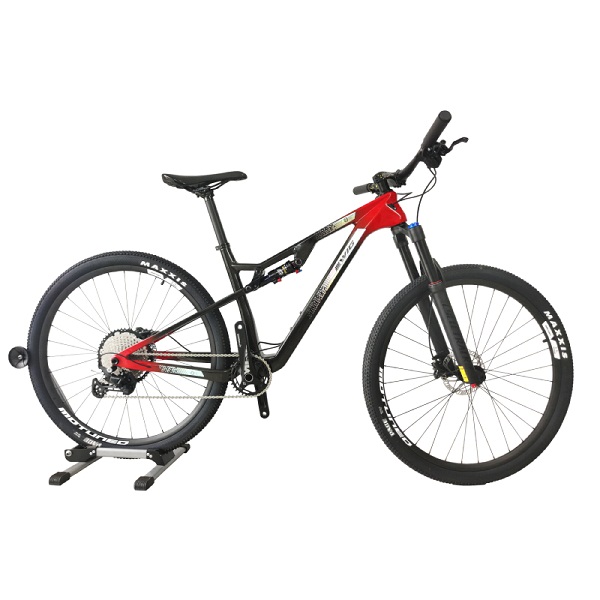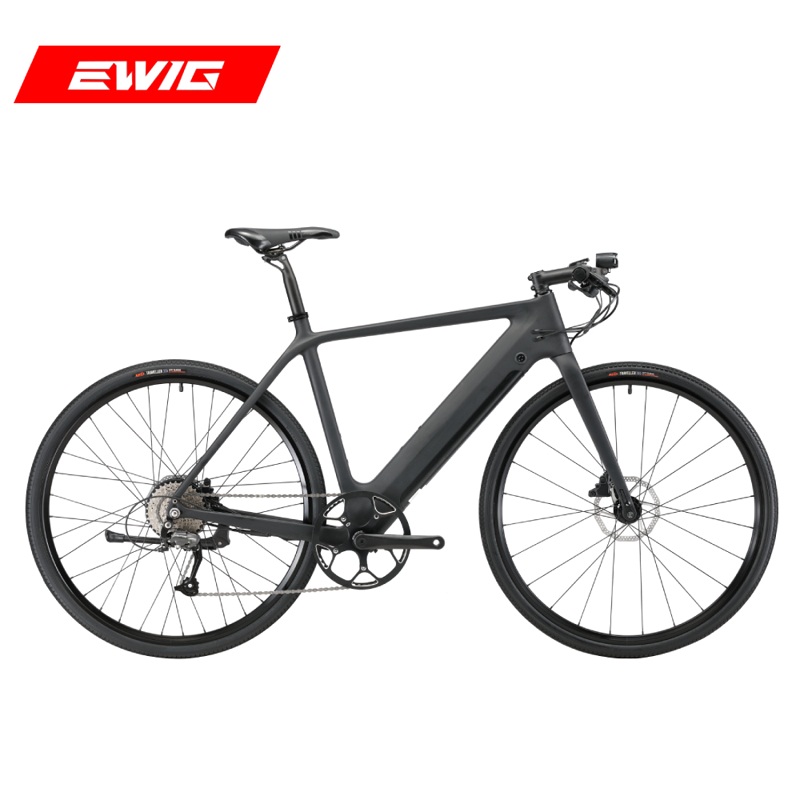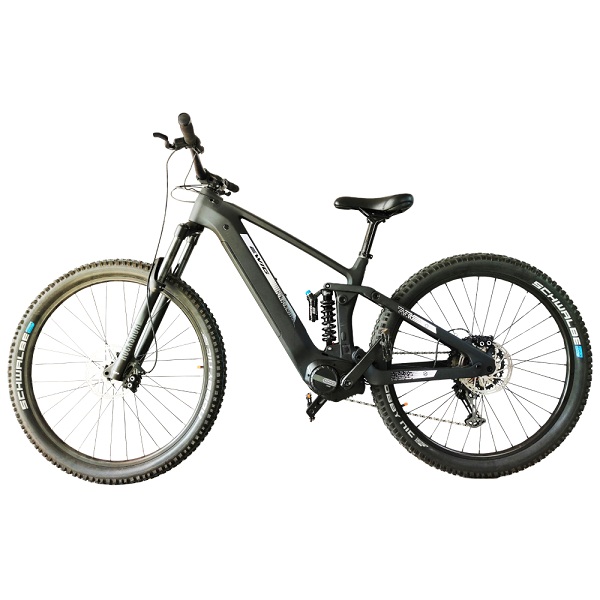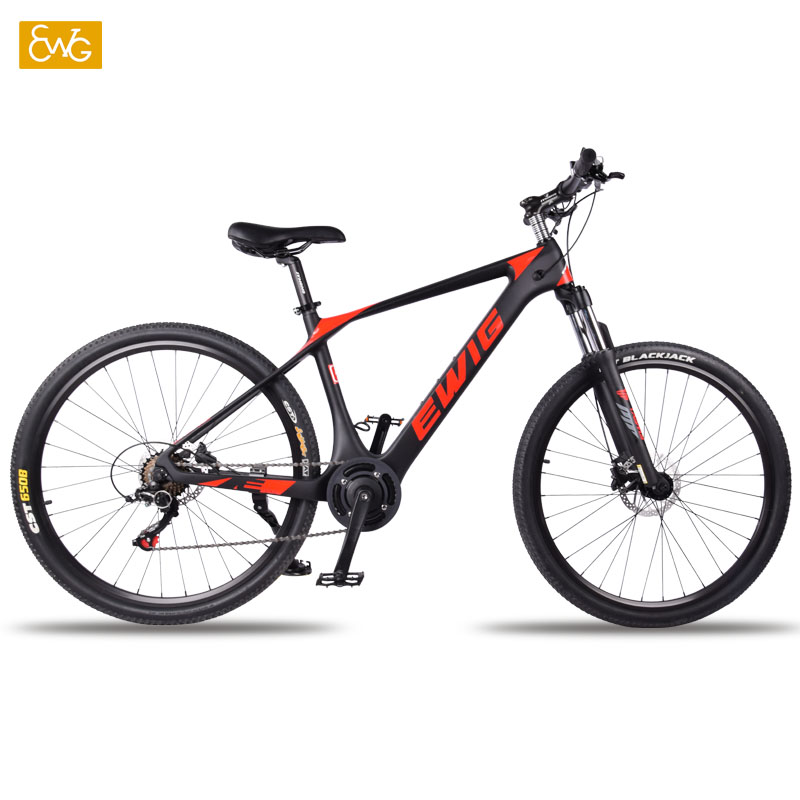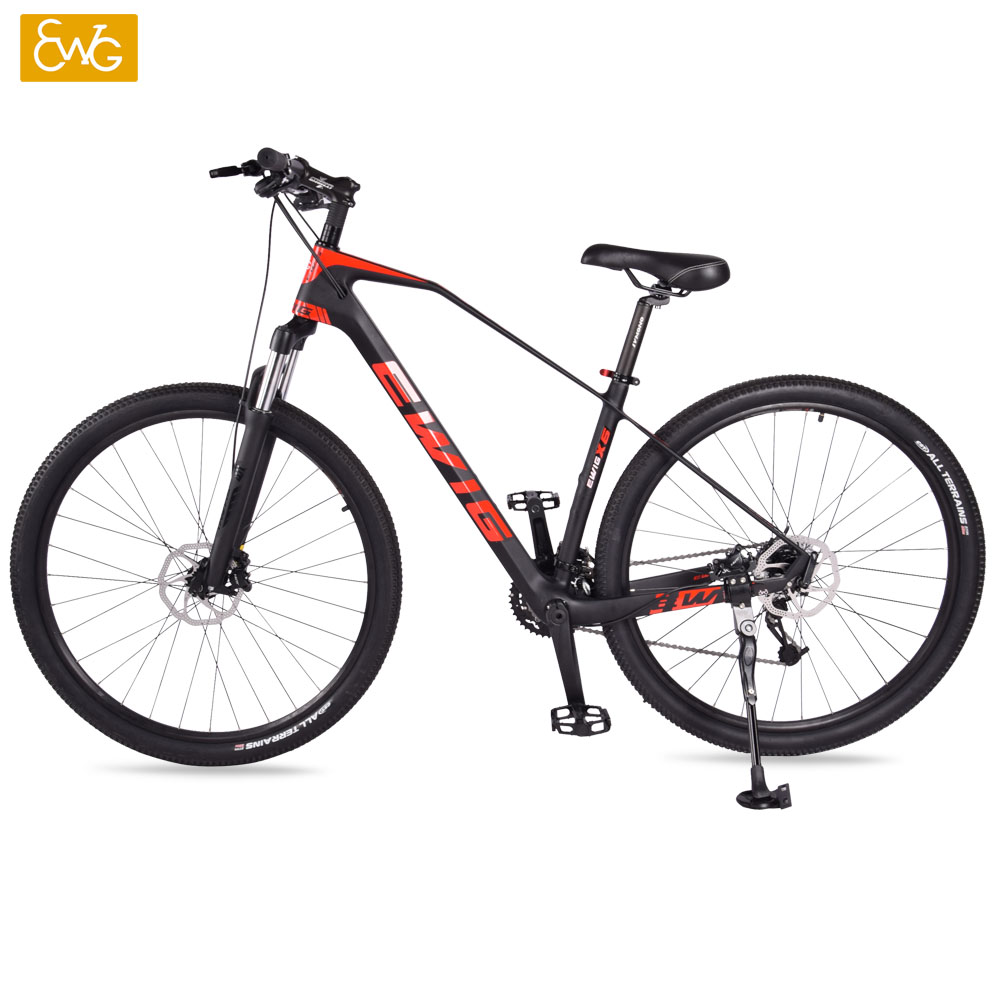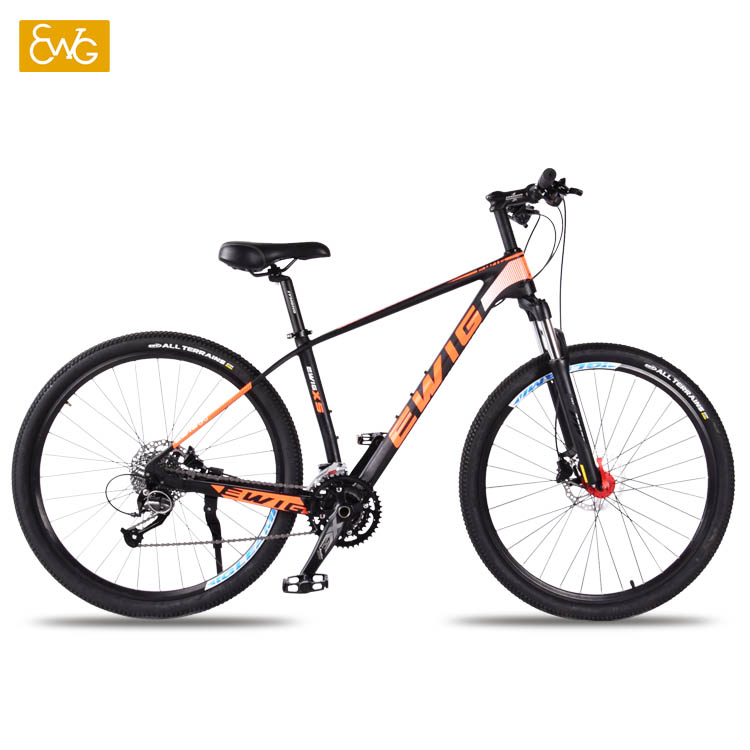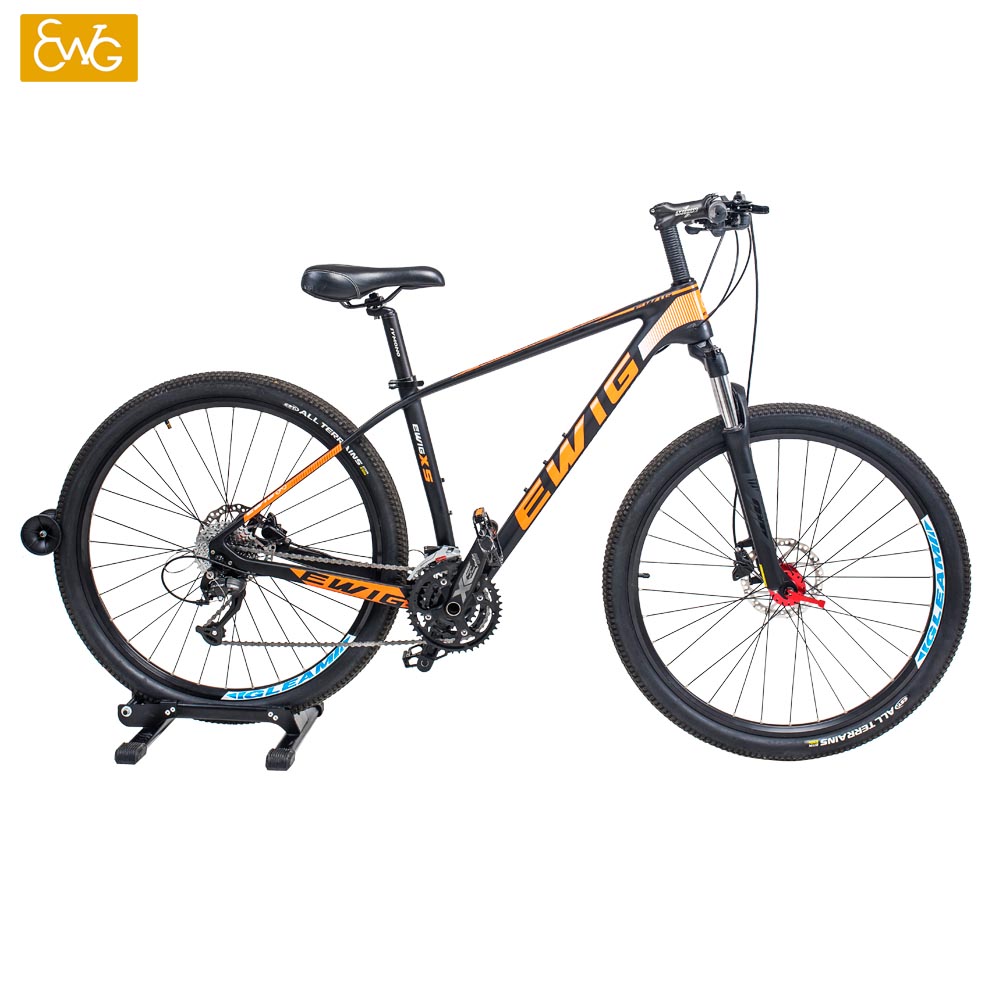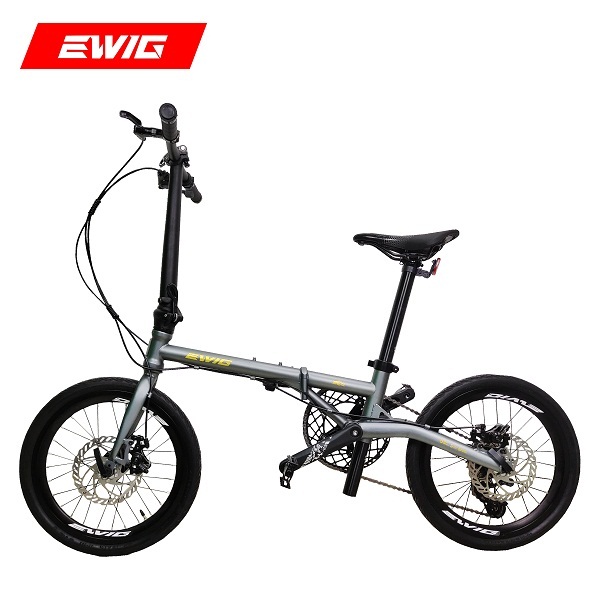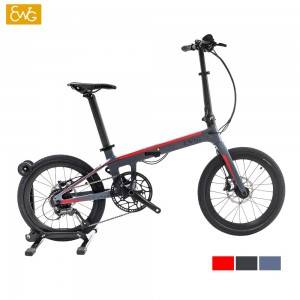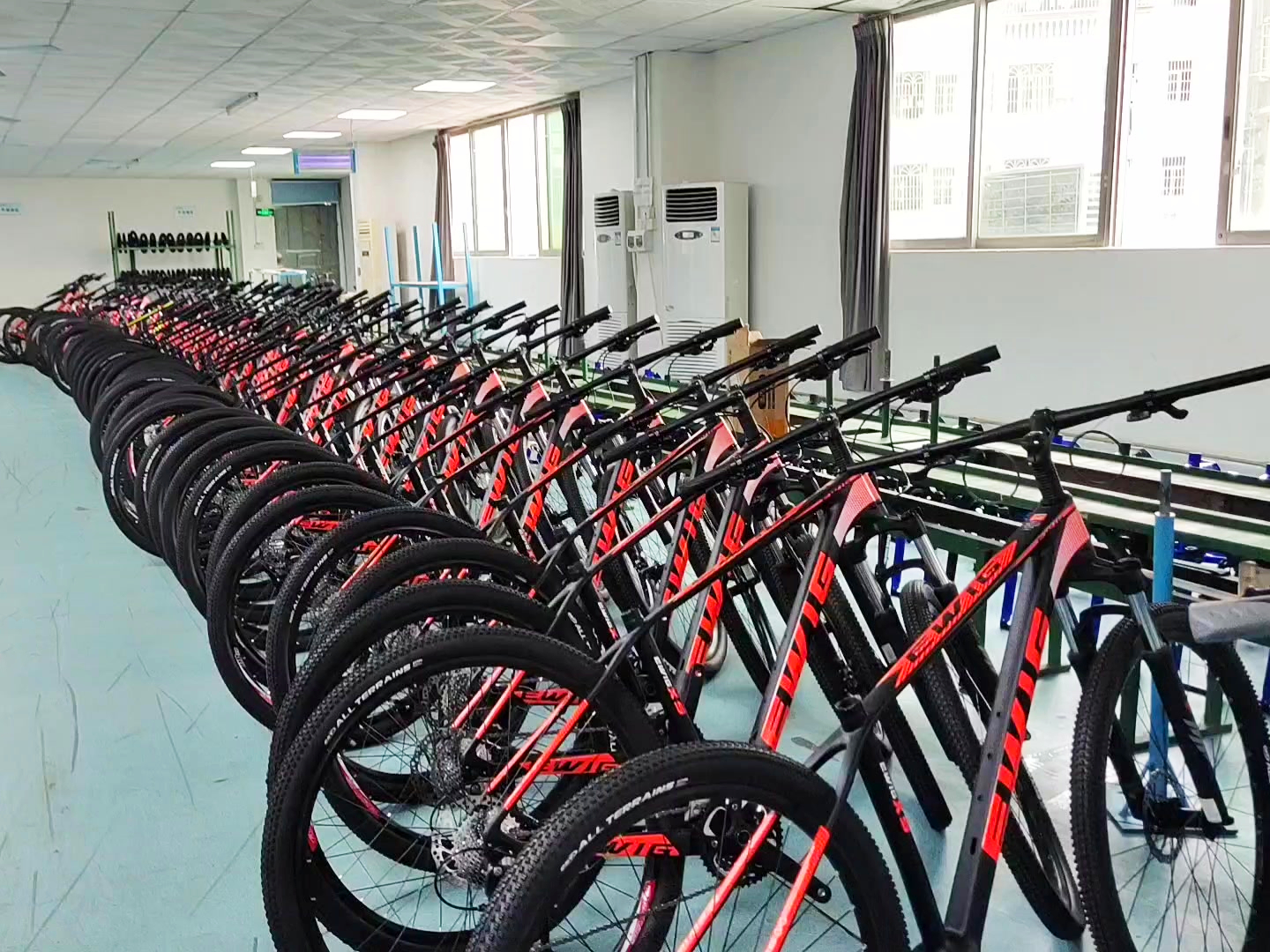
Best Carbon Mountain Bike Manufacturer,factory In China
The EWIG carbon mountain bikes are designed and manufactured to the rigors of mountain biking so they're strong, durable, extremely capable, and light.
As the best bike manufacturer vendor & supplier, we accept OEM & ODM service, send us your design we can make the real sample in 15 days, put your logo and color on the bike, made from the material carbon firber and alloy.
After years of development, we got a strong partnerships with SHIMANO, MAXXIS, FIZIK, PROPALM, TORAY etc.
Specialized Carbon Fiber Mountain Bike
These typically include a suspension fork, large knobby tires, more durable wheels, more powerful brakes, straight, extra wide handlebars to improve balance and comfort over rough terrain, and wide-ratio gearing optimised for topography and application (e.g., steep climbing or fast descending).
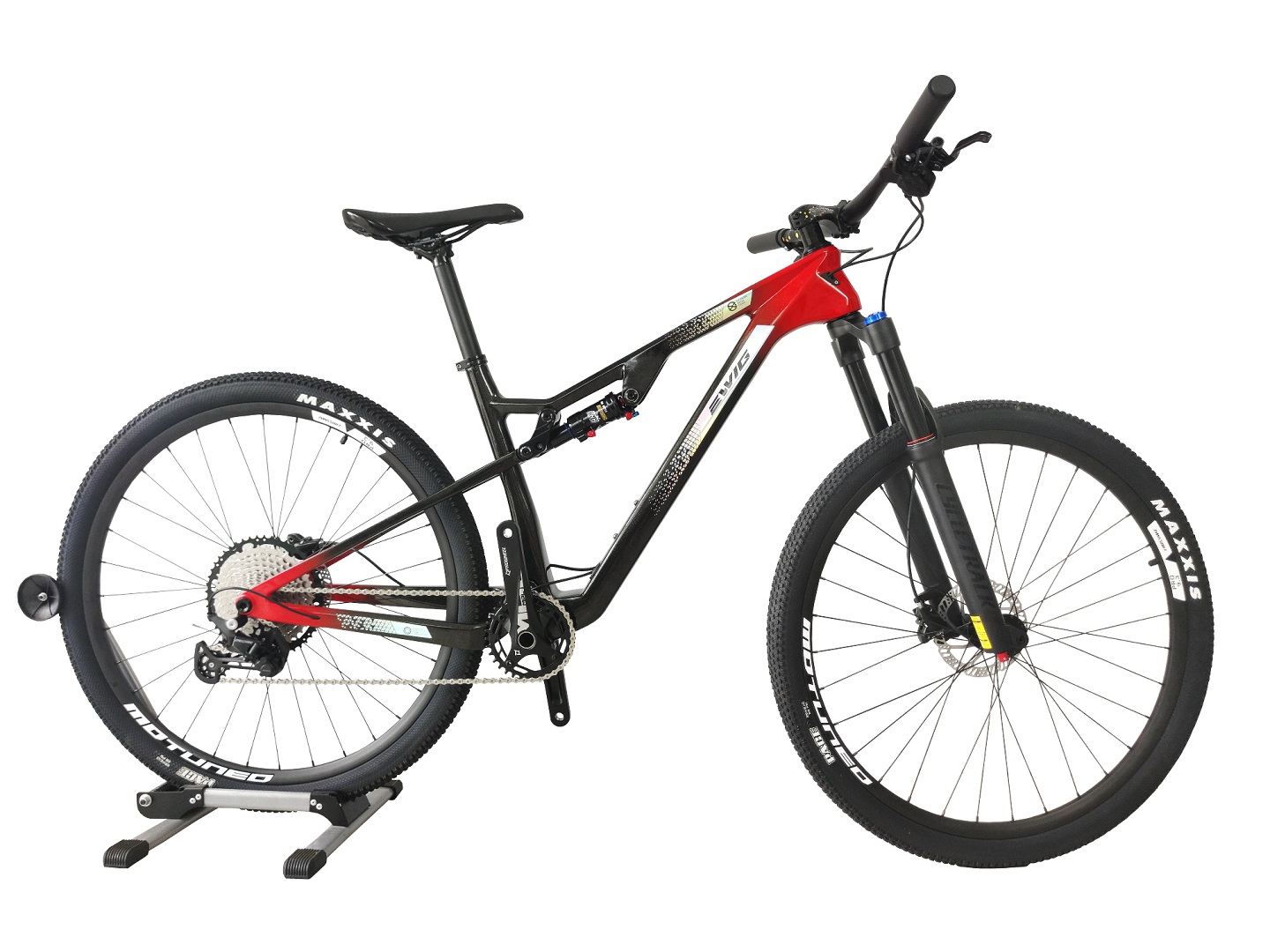
Choose Your Carbon Fiber Mountain Bikes
Our goal is to offer the absolute best customer service possible,pls trust we can do that.You can buy a stock-built bike or fully customize it. We fully build every bike so you can ride it within minutes of arrival, with some light assembly.We have a no-nonsense lifetime warranty, we ship anywhere in the world and a lifetime crash replacement policy.Call or email us anytime at 0086-752-2233951(sales2@ewigbike.com) to build the bike of your dreams.
Become A Distributor
Would you like to add our product range to your catalog and then distribute it in your region?
Why Choose Us As Your Carbon Bikes Supplier In China
As a professional carbon bike manufacturer and factory, our positioning is to be a customer’s technical, production, after-sales, R&D team, quickly and professionally provide various mountain bike solutions to solve various bike problems encountered by customers. Our customers only need to do a good job in the sales of mountain bike, the other things such as controlling cost, bike design & solutions, and after-sales, we will help customers deal with it in order to maximize customer benefits.
Have a Special Requirement?
Generally, we have common carbon bike products and raw materials in stock. For your special demand, we offer you our customization service. We accept OEM/ODM. We could print your Logo or brand name on bike body and color boxes. For an accurate quotation, you need to tell us the following information:
Frequently Asked Questions
There is no the lightest production frame on earth, each carbon bike manufacture will spend time fine-tuning the fiber and resin mix, as well as custom shaping every ply to eliminate unnecessary carbon overwraps. A painted medium ewig mountain bike frame weighs a mere 775 grams (+/– 15 grams). They also boosted capability, comfort, and versatility. If isn't in budget, then ewig X5 frame weigh an impressive 915 grams—considerably lighter than most brand’s top-shelf offerings.
In terms of frame weight,ewig carbon fiber X5 hardtail isn’t crazy light at over 1kg, but they’ve done something radical to get complete bike weight low enough to kill on the climbs. The kinked, super-flat top tube is designed to help dissipate the extra shock coming through from the front end too, although the long, tapered, carbon legs deliver a smoother ride than you’d expect. The super-slim stays are designed for extra flex but there’s still plenty of meat around the cranks and chainstays for kicking hard and making that low weight count. The fork is also the same length as a 100mm travel unit so swapping around won’t disturb the agile, short wheelbase handling.
For a long time, 26-inch mountain wheels were standard, but have now been phased out in favor of larger rims.
New bicycle these days basically come with 27.5-inch (also known as 650b) or 29-inch wheels. Larger wheel diameters have stronger versatility and greater traction, but the disadvantage is that larger wheels have slower acceleration, less flexibility in corners, and height requirements. If you like to ride on tight, twisty and steep trails, the 650b is probably better.However, there is also a compromise solution, that is, a mixed wheel diameter, which is a 29-inch front wheel and a 27.5-inch rear wheel, which is also a new addition to many brand new cars in recent years. It ensures front wheel versatility and rear wheel flexibility.
Suspension designs for bicycles, although there are various variants, some high-end bikes are quad-link construction, and many brands have been "quad-link construction". "The design is patented. The four-link structure allows the suspension to be independent of braking motion, and the designer has more room to maneuver with the lever ratio.
Horst-Link was designed and patented by Horst Leitner, and many companies have purchased the patent
No matter which bike you're using, which build, how much it costs, or how the bike manufacturer advertises it, these suspensions arguably make some compromises. A design that excels on one metric is bound to undercut on another, but that doesn't mean you can't find the bike that's right for you.
Bike manufacturers have now eliminated all bad suspension designs from their systems. The differences between them are already very subtle, it is more important to understand bike suspension theory and setup.
Suspension designs for bicycles, although there are various variants, some high-end bikes are quad-link construction, and many brands have been "quad-link construction". "The design is patented. The four-link structure allows the suspension to be independent of braking motion, and the designer has more room to maneuver with the lever ratio.
Horst-Link was designed and patented by Horst Leitner, and many companies have purchased the patent
No matter which bike you're using, which build, how much it costs, or how the bike manufacturer advertises it, these suspensions arguably make some compromises. A design that excels on one metric is bound to undercut on another, but that doesn't mean you can't find the bike that's right for you.
Bike manufacturers have now eliminated all bad suspension designs from their systems. The differences between them are already very subtle, it is more important to understand bike suspension theory and setup.
Tiffness is how much your bike resists bending. The stiffer the bike, the less effort you need to control it. With a carbon mountain bike, you are looking at two kinds of stiffness: the lateral stiffness and the stiffness of its handling. The former affects the transition of your energy from pedal to the road, while the latter determines your bike’s predictability when being controlled.
Carbon is stiffer than aluminum. It responds more quickly to forces on the pedals and handlebars. This quality makes it easy to control but might offer some disadvantage when running through high-speed runs and encountering substantial obstacles. Here is a carbon MTB with a high stiffness. Manufacturers are making aluminum frame tubes a larger diameter to increase stiffness. Moreover, advances in welding and hydroforming are creating stiffer and lighter aluminum models.
Overall, the choice between carbon and aluminum depends on you. In terms of stiffness, carbon still reigns supreme, but aluminum is slowly offering a competitive edge. While cost may not be the central part of your decision, if you go with a cheaper aluminum frame, it will not disappoint.
The process to make carbon bike is precise and time-consuming. Any deviations or faults in the process will make a dangerously unusable frame. This process must be done by hand, cured at precise temperature in a vacuum to avoid air pockets that weaken the carbon fiber structure.
The chain stays and seat stays get a different grade of carbon fiber than top tube, down tube, forks and bottom bracket. High-stress areas like the headube and bottom bracket require more layers for strength, stiffness and overall safety.
To say this is time-consuming and complex is no understatement. Good carbon fiber sufficient to handle the stresses and forces exerted by a champion cyclist is not cheap either.
Compared with titanium, the price of carbon fiber frame is more than ever, to the top of the carbon fiber frame prices are tens of thousands of dollars, This is mainly because the production process of carbon fiber frames requires a lot of manual work, and the scrap rate is very high, resulting in a large increase in costs.
Is it actually worth it to pay more? Of course, there is no one answer. Value is subjective and based on your needs, goals, riding style, and budget.
Mountain bikes come at a variety of different price points, with most falling in the $200 to $10,000 range — a pretty big spread. The biggest factors that should determine mountain bike prices are the frame material and components used to create them.
Carbon folding bikes are convenient to store in small spaces, though they can be a bit on the heavy side. Some indepedent designers are turning to crowdfunding to get their lighter.
The average folding bike weighs in at around 8kg, but they can vary from just over 8kg to up to 10kg. As mentioned above the weight of a folding back is extremely important. Especially if you are likely to spend a lot of time carrying and manoeuvring your bike around by hand.
As mentioned above the weight of a folding back is extremely important. Especially if you are likely to spend a lot of time carrying and manoeuvring your bike around by hand.
The weight of fold-up bikes can differ quite a lot when it comes to their weight and this is often down to the materials they are made from. For example, a carbon frame folding bike can combine your need for a lighter bike that is still sturdy and strong, and it is also extremely light, and can save you several kilos compared to a steel folding bike.
Carbon mountain bikes are very durable in general. The power-to-weight ratio is 18 percent higher than aluminum. High-end mountain bike frames can take up to 700 KSI (kilopound per square inch) before they snap.
A carbon bike is more aptly described as a bike with a carbon composite structure. This means the bike is not made of pure carbon; it also has several other components such as epoxy resin. Carbon is the reinforcing fiber that could be sourced either from glass or Kevlar. It is the epoxy resin that fuses them together.
In order to come up with high-quality carbon bikes, advancements have been made in the manufacturing of stronger carbon filaments and their binder, which is resin.
I have mentioned that a carbon bike is basically made from carbon-fiber composite. The specific strength or power-to-weight ratio is high, which is roughly 18 percent more than aluminum. This means the bike becomes more susceptible to extreme loads during an impact.
Just like other materials, carbon will deteriorate with usage albeit, only after a long time. Carbon has the longest frame fatigue which enables many manufacturers to offer a lifetime warranty on frames made with this material. When aging happens, the resin matrix would be forming little cracks, and all that’s left are the connections of the fiber. The stiffness of the bike frame will slightly change in the process.
Ultimately, you can be assured that when you consider a carbon bike, it will be a durable piece of equipment.As much as you can, you must avoid moderate to high impact on your bike, regardless of what material it is made of, for the sake of not only your bike, but also your own safety.
Bicycle frames of 1200 grams can already be seen everywhere. For carbon fiber frames, this weight is generally the same. Today, the lightest carbon fiber frame is more than 900 grams, which is very light. The performance of the carbon fiber frame is not bad. It has a better ability to absorb impact, that is, it can effectively absorb shocks, make the rider’s riding process more comfortable, and also has good rigidity, so the price is more expensive.
1. Best overall
2. Strong yet lightweight
3. Good suspension
4. Highly effective brake
5. Continental tires
Carbon fiber is chemically stable, corrosion-resistant, and won’t rust. It’s worth noting that carbon fiber composites may cause galvanic corrosion when in contact with some metals. While it won’t lead to evident surface corrosion in the short-term, corrosion products add up and lead to damage with time.
Aluminium can be a little more ‘forgiving’. It is often popular for cycling disciplines like crit racing, downhill and freeride mountain biking where there is a high likelihood of taking a tumble due the nature of the racing. It's possible for these types of frames to be put through certain impacts but still be strong enough to continue using. However, we would stress that any impact to a carbon or aluminium frame should be inspected by an experienced mechanic before being ridden again.
the carbon frame falls on the ground, there will basically only be lacquer, and if the stone tip is hit, there will be a risk of breakage, but overall it will be stronger than the general aluminum frame.
Bicycle frames of 1200 grams can already be seen everywhere. For carbon fiber frames, this weight is generally the same. Today, the lightest carbon fiber frame is more than 900 grams, which is very light. The performance of the carbon fiber frame is not bad. It has a better ability to absorb impact, that is, it can effectively absorb shocks, make the rider’s riding process more comfortable, and also has good rigidity, so the price is more expensive.
Most of our ewig MTB bikes will use T700 carbon fiber frame, SHIMANO ALTUS/ SHIMANO DEORE/SHIMANO SLX.. groupset. CTS TIRE. all spare parts that provide high technical efficiency in response to the market demand.
The comparison between carbon fiber and other exotic materials is always inevitable. For this reason, titanium couldn’t be out of the list but, is it really stronger than carbon fiber? This is not a so simple question to answer because carbon fiber is not an isotropic material,
Theoretically, carbon fiber can be as much as 3 times stronger than titanium when stress is aligned with its fibers. However, when stress is 45° off-axis, it can be almost 3 times weaker. In real-world applications, carbon fiber can be as much as 2 times stronger than titanium when advanced computational engineering and manufacturing are employed.
Carbon composite forks are no longer just for big budget racers but encompass a wide range for all kinds of riding, from time-trial to audax and even commuting.
Fitting a carbon fork will have less of an effect on your bike’s performance than, say, fitting lighter wheels, but that weight saving will certainly have a significant influence.
Carbon Mountain Bikes: The Ultimate Guide
Mountain bikes are generally specialized for use on mountain trails, single track, fire roads, and other unpaved surfaces. Mountain biking terrain commonly has rocks, roots, loose dirt, and steep grades. Many trails have additional technical trail features (TTF) such as log piles, log rides, rock gardens, skinnies, gap jumps, and wall-rides. Mountain bikes are built to handle these types of terrain and features. The heavy-duty construction combined with stronger rims and wider tires has also made this style of bicycle popular with urban riders and couriers who must navigate through potholes and over curbs.
Chapter 1: Types of Carbon Mountain Bike
Most mountain bikes have suspension to keep you in control over rough ground, but not all mountain bikers need the same amount and type of suspension. Hardtail mountain bikes do not feature a rear shock, whereas full suspension bikes feature front and rear shocks. Full suspension mountain bikes keep you in control and comfortable over rugged terrain.
Hardtail mountain bikes
If you are concerned about the future cost of bike maintenance, or live in a geography where muddy rides are the norm, any hardtail is much cheaper to own. Full-suspension bikes require shock services and linkage bearing replacements, which can rapidly add to the cost of ownership if you often ride in boggy conditions.
The hardtail is also more adaptable for riders who use their mountain bike as an all-purpose cycling vehicle. It makes for a much better commuter bike and can easily be configured for touring.
Hardtails can be fun on mildly technical descents if they have the appropriate geometry and a decent suspension fork
• More efficient while pedalling
• Faster on climbs and smooth trails
• Lighter weight
• Great for beginners and easier terrain
• Simpler to maintain
• Natural choice for cross country racing
Full-suspension mountain bikes
Mountain bikers carrying some injury tension will always be more comfortable on a full-suspension bike on any terrain. For those riders who are healthier, wish to develop their skills, and explore more demanding trails, the full-suspension mountain bike is a much safer passage to progression.
If you live in an area where most of the trails are smooth and flowing, the difference between a hardtail and a full-suspension bike is marginal. It has lower maintenance and is more efficient at converting energy to forward momentum.
Rocky and rooty trails can become a bit more of a challenge on any hardtail, however. This is where even a short-travel full-suspension bike gives much better confidence and control. for repetitive hits, a full-suspension bike is going to be kinder on your body.
• More capability and versatility
• Faster on difficult trails with lots of obstacles
• Increased stability in the bumps and while descending
• Instant confidence boost for beginners
• New technologies make them more efficient than ever
• Smart choice for all types of racing
Chapter 2: Benefits Of Carbon Mountain Bike
More efficient while pedalling
Both, of course, have their pros and cons. Nothing can beat a hardtail for flat-out climbing speed and efficiency, but they suffer on the technical features found on modern cross country courses.
This is where a full-sus machine excels, happily soaking up descents, roots, rock gardens and drops, at the expense of added weight and a slight loss of pedaling efficiency.
The hardtail was a winner on the rooty lap, being faster for less effort. But the results were more confusing on the rough lap. The full suspension was quicker on the descent for less power, but required more power to maintain the same speed pretty much everywhere else on the course, particularly going uphill.
Great for beginners and easier terrain
Hardtail mountain bikes are certainly easier for beginners to maintain compared to a full-suspension mountain bike. With the absence of rear suspension, there are fewer moving parts that need regular servicing
If you’re starting out in mountain biking the chances are the terrain you intend to ride won’t be technically demanding enough to warrant a full-suspension setup. Hardtails are simple, yet fun mountain bikes and are the perfect tool for honing your skills and enjoying mountain adventures.
Hardtails are energy efficient machines: you’ll find climbing easier due to the absence of extra moving parts (rear suspension) and also because they’re lighter.
Simpler to maintain
If you want to do everything you can to protect your investment. From frequent baths to yearly tune-ups, its normal to make sure you’re doing everything you can to get the most out of your Mountain Bike.
Hardtail mountain bike suspension systems have only one fork, while full-suspension models have a fork and rear suspension paired. There are definitely pros and cons to both, hardtails have direct power, high pedaling efficiency, hardtails are also easier to maintain, have no hassle of turning point maintenance, and tend to be more budget-friendly, usually the first choice for entry-level users.
Natural choice for cross country racing
The first thing you need to decide is how you’ll use your new hardtail. Figure out your skill level and where you want to ride: your nearest bike park, exploring your local singletrack trails or a few rides with the family.
Faster on climbs and smooth trails
Hardtails are great for goofing off, hitting jumps, riding some street trials, or just enjoying on the same trails as usual. Hardtails are a little rougher, but that just adds to the sense of speed, even if you’re not riding as fast. They can even be more fun on some trails: the kind of trail that isn’t too rough and needs a bit of pedaling, a sweet jump trail, or a fresh secret trail where you’re surfing loam all the way down. It’s hard not to have fun on a hardtail, and after all, fun is the reason that most of us ride.
Lighter weight
For weight, performance and reliability come high on your list of priorities but your budget it is tight, a hardtail could be the best choice. Heavier riders with more power may benefit more from the control a hardtail MTB bike offers.
Chapter 3: Material of frame: carbon frame / aluminium frame
Choosing what material you want your frame to be made from is one of the key decisions to make when buying a bike.
Bike frames have been made from a variety of different materials over the years, with steel originally dominating. Now the major choice is between aluminium and carbon fibre.
Each frame material has its pros and cons, depending on your priorities as a rider, including weight, budget, longevity and the performance characteristics you want from the frame and, as a result, the bike.
Aluminium is the go-to metal for budget to mid-range frames, providing a combination of low weight, stiffness and affordability that’s hard to beat.
Aluminium is the material used for the majority of cheaper bike frames but it’s still a popular choice for some pricier, performance-focused frames, both on the road and, in particular, for mountain bikes.
While the exact properties of an aluminium alloy frame will vary from one bike to the next, typically it’s relatively lightweight with a high level of stiffness, robust and around a fifth of the price of carbon fibre.
An alloy frame can actually be lighter than a carbon fibre one at a similar price, although expensive carbon frames will always be lighter still.
carbon fibre has been the go-to material for high-performance bike frames.It is a highly-adaptable wonder material that can be shaped and fine-tuned to precise requirements, balancing stiffness, comfort and aerodynamic performance.Carbon fibre bike frames are expensive and can be more susceptible to crash damage than other materials.
Not all carbon is created equal though. Lower-grade (or modulus) carbon has more fillers, which reduces cost but adds weight. It is possible for a lower-modulus carbon frame to weigh more than a high-end aluminum frame.

